On the morning of November 20, the Department of Culture, Sports and Tourism of Da Nang City held a consultation seminar on plans to protect and excavate ancient ship relics recently discovered in the coastal area of Hoi An (Hoi An Tay Ward, Da Nang City).
Priceless Documentation
The ancient ship relic was discovered by local people at the end of 2023 on the Hoi An coast, passing through Thinh My block (Hoi An Tay ward, Da Nang city). Since then, the relic has undergone many times of silting up and appearing at different levels. After the storm in early November, the coastline eroded severely, causing the upper part of the ship to almost completely appear, with a width of about 5 m and a length of 17.4 m.
Survey, sampling and appraisal results show that the discovery site was once land 700-800 m from the water's edge in 1905; sediment samples did not preserve pollen, proving that the shipwreck occurred in a marine environment. The ship was crafted from at least three types of durable wood: Lagerstroemia, Acacia, and Pine; its structure is sturdy, bearing the mark of a combination of Southeast Asian and Chinese techniques. Existing data shows that the ship is likely to date from the mid-late 14th to the 16th century.
Experts assess this as an exceptionally rare discovery, of great value to the study of maritime history and cultural heritage of the Central region. At the same time, it serves as the only material document to help further research on economic activities and ancient trade in the Da Nang - Hoi An region.

Ancient ship discovered on Hoi An coast
PHOTO: MANH CUONG
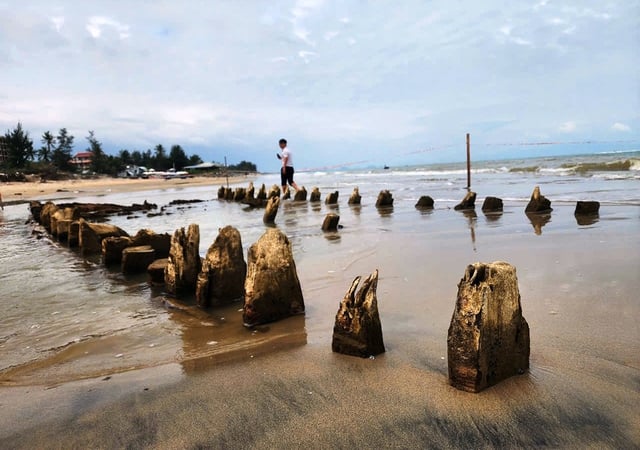
The ship was crafted from at least three types of durable wood including Lagerstroemia, Acacia, and Pine.
PHOTO: MANH CUONG
The Hoi An Center for Cultural Heritage Management and Preservation has proposed to allow urgent excavation and urgent preservation to protect the original state of the ship's hull structure. The plan is to use Larsen piles to prevent water, perform rolling separation and parallel preservation. The excavation will be carried out in a grid pattern, separating soil from the hull to the sides and bottom, keeping a protective layer of soil 15 - 20 cm above the wood surface. When the wood is exposed, it will be covered with moist canvas, recorded, measured, photographed, and reinforced to ensure the shape of the hull during the salvage process. The excavation is expected to last 45 days, from December 2025.
Dr. Nguyen Van Viet, Director of the Southeast Asian Prehistory Center, said that after the initial survey, archaeologists agreed that the level of integrity of the ship was amazing, almost undisplaced. This is especially important when excavating the part of the ship lying on the biosoil layer, scientists can collect environmental, landscape and historical data at the time the ship sank. This is invaluable material to reconstruct the ancient economic - cultural - trade context of Hoi An and the Central region.
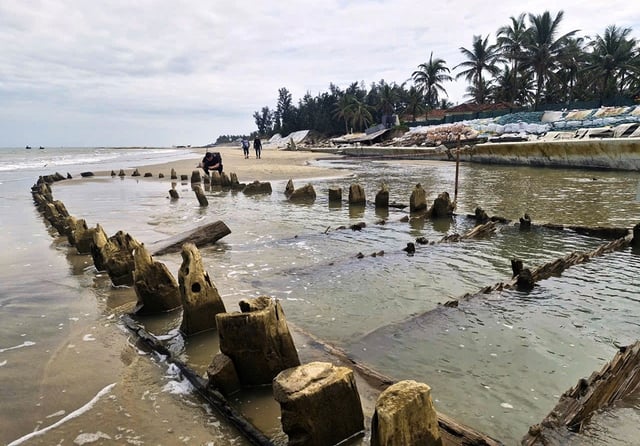
The ship was first discovered in late 2023.
PHOTO: MANH CUONG

Available data suggests the ship likely dates from the mid-late 14th to the 16th century.
PHOTO: MANH CUONG
According to Dr. Viet, the appearance of the ship is both a challenge and a rare opportunity in many decades. To excavate safely, the construction of a protective dyke must be implemented immediately, because this is a key technical factor to protect the entire process. He proposed the compartmental excavation method, a technique widely applied in the world. Specifically, dividing the ship into independent compartments, processing each part to ensure maximum integrity. All structures such as the ship's bones, hull, living utensils, even the sailors' personal belongings (if any), must be preserved in place and immediately processed using water or refrigeration technology.
In parallel, a field technical room needs to be built right next to the excavation pit, because the golden time to preserve submerged artifacts is only a matter of minutes. 3D scanning the entire ship during the excavation process will help store absolutely accurate data, creating the premise for early restoration of the display model for the museum and serving long-term research.
"We are facing an unprecedented opportunity to rescue and restore a priceless heritage of the nation. This is not only the task of the archaeology industry, but also a responsibility to the history and future of the country," Dr. Viet emphasized.
UNIQUE VALUE
Dr. Nguyen Ngoc Quy, Institute of Archaeology (Vietnam Academy of Social Sciences), affirmed that when directly approaching the site, the research team realized that the value of the ship far exceeded all previous analyses. The ship is located in the cultural space of the Quang region's boat culture and is currently the only remaining relic that can clearly demonstrate this culture. That creates an irreplaceable uniqueness. Therefore, the research team invited interdisciplinary experts from conservation, relocation to excavation techniques to develop a master plan. Dr. Quy also emphasized that linking the heritage with the ancient urban space of Hoi An will create a new cultural and tourist destination, similar to the way many countries have successfully exploited famous shipwrecks in the world.

Dr. Nguyen Ngoc Quy, Institute of Archaeology, expressed his views at the seminar.
PHOTO: MANH CUONG
Mr. Tran Dinh Thanh, Deputy Director of the Department of Cultural Heritage (Ministry of Culture, Sports and Tourism), acknowledged that the ship is attracting great attention from experts and the community. If fully researched and preserved, it will add important evidence to the history of maritime trade in Hoi An and the Central region.
Mr. Thanh said that there are two main excavation options being considered. The first is to lift the ship in one piece, an ideal solution but with high risks due to the ship's age and possible deformation of its structure. The second is to disassemble it in parts according to conservation principles, which is more feasible and is applied by many countries; numbering and detailed documentation will allow for future restoration of the ship. He agreed that both options should be prepared in parallel, with priority given to feasibility and safety.
According to the Deputy Director of the Department of Cultural Heritage, regarding preservation plans, international experience, especially from Japan, shows that the use of chemicals and water extraction processes are very effective for underwater wooden relics. However, Vietnam currently does not have a set of standard procedures for these techniques. Therefore, it is necessary to develop complete procedures, regulations, and standardize each step, ensuring absolute safety before implementation.
"If done well, this excavation will not only bring scientific value but also create an important precedent for underwater archaeology in Vietnam," Mr. Tran Dinh Thanh affirmed.
Thanhnien.vn
Source: https://thanhnien.vn/tau-co-phat-lo-o-bo-bien-hoi-an-thoi-co-vang-de-giai-ma-lich-su-giao-thuong-185251120213930478.htm



![[Photo] President Luong Cuong receives Speaker of the Korean National Assembly Woo Won Shik](/_next/image?url=https%3A%2F%2Fvphoto.vietnam.vn%2Fthumb%2F1200x675%2Fvietnam%2Fresource%2FIMAGE%2F2025%2F11%2F21%2F1763720046458_ndo_br_1-jpg.webp&w=3840&q=75)
![[Photo] Visit Hung Yen to admire the "wooden masterpiece" pagoda in the heart of the Northern Delta](/_next/image?url=https%3A%2F%2Fvphoto.vietnam.vn%2Fthumb%2F1200x675%2Fvietnam%2Fresource%2FIMAGE%2F2025%2F11%2F21%2F1763716446000_a1-bnd-8471-1769-jpg.webp&w=3840&q=75)

![[Photo] General Secretary To Lam receives President of the Senate of the Czech Republic Milos Vystrcil](/_next/image?url=https%3A%2F%2Fvphoto.vietnam.vn%2Fthumb%2F1200x675%2Fvietnam%2Fresource%2FIMAGE%2F2025%2F11%2F21%2F1763723946294_ndo_br_1-8401-jpg.webp&w=3840&q=75)
![[Photo] National Assembly Chairman Tran Thanh Man holds talks with President of the Senate of the Czech Republic Milos Vystrcil](/_next/image?url=https%3A%2F%2Fvphoto.vietnam.vn%2Fthumb%2F1200x675%2Fvietnam%2Fresource%2FIMAGE%2F2025%2F11%2F21%2F1763715853195_ndo_br_bnd-6440-jpg.webp&w=3840&q=75)





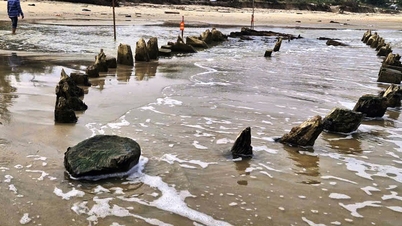






































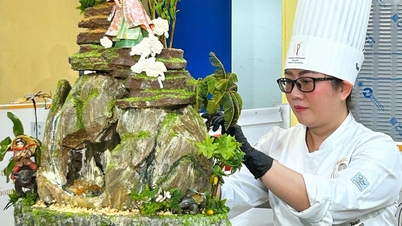





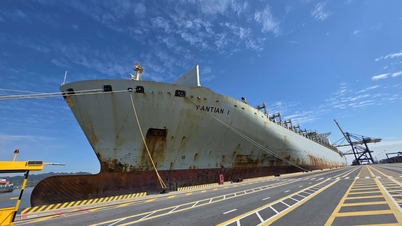






















































Comment (0)